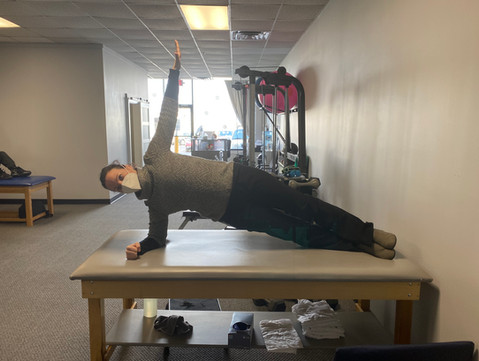Core Series: Part Two
- JenDion
- Jan 27, 2021
- 3 min read

This post is the second of our series on the core. The core is made up of muscles that are located all around the trunk and hips, not just your abdominals in the front. These muscles are important because the stronger your core is, the more protection your spine has. In this post, we are going to go over the sides of the trunk and the important muscles that help with rotation.

You have two oblique muscles on each side of your torso that control trunk flexion, side bending to the same side, and trunk rotation to the opposite side. They originate on your lower ribs (5-12) and insert on to the hip and pubis. Another unseen but important purpose of the obliques are aiding in forceful exhale which helps bring more oxygen to your system (Gorman, 2020).
One of the best strengthening exercises that targets this muscle is side planks. To get into a modified side plank lay on your right side in a straight line from head to toe (see picture below). Bend your bottom knee to use as a platform keeping both knees next to each other. Keeping your elbow underneath your shoulder, lift up your hips from the floor. Start with a 30 second hold. If this is too easy you can choose to do a full plank by extending your bottom knee so both legs are stacked on top of each other (see picture below).
Modified Side Plank Side Plank

The next muscle is located on the back of the trunk and helps with rotation. The quadratus lumborum originates on the top of the hip bones on your back and runs up the spine attaching to all vertebrae of the lumbar spine. This muscle helps extend your back and bend to the opposite side. It can sometimes be tight so it is important to stretch it. See the picture below for a good stretch!

QL stretch
Position to stretch LEFT quadratus lumborum: with a chair to your right hand side, start in a kneeling lunge position with your left knee on the floor and right leg in front. Lift your left arm to the side like your doing a jumping jack and bend your trunk to the right. Use your right hand to stabilize you with the chair. Hold for 30 seconds and repeat 3 times. Repeat on opposite side.

The gluteus medius is on the side of your hip but is very important for stability, walking, running, and single leg weight bearing. It starts on the posterior lateral (back/outside) ridge of the hip bone called the illium and spans down in a fanlike fashion to insert on a point of your femur (leg bone) called the greater trochanter. It helps keep your hips level when you are standing on one leg. This happens when you are walking and transition your weight from one leg to the other. Everyone can benefit from strengthening this muscle to take the load off of your low back when moving. Fun fact- By strengthening the glute medius and you can improve your own balance!
A good exercise to work on the gluteus medius is called the clamshell. To work your left side, lay down on your right side, with your shoulder, hip, and ankle in a straight line, knees bent up towards your chest. Using your core to keep both hips stacked on top of each other and heels staying glued together, bring your left knee up towards the ceiling. Make sure that the top hip does not roll backwards by using your core to stay in alignment especially at the top of the range. Try 2 sets of 15 reps on both sides. See video below!
Clamshell- left side demonstrated above
Stay tuned to the third part of the core series where we will go over the core muscles on your backside. If you currently have pain or would like to prevent jury contact us at Dion Physical Therapy for a specialized plan of care. Questions? Feel free to email or call! Ph: 774-955-5830.
Email: Jennifer.Dion@dionpt.com
References
Gluteus Medius. (n.d.). Retrieved January 20, 2021, from https://www.physio-pedia.com/Gluteus_Medius#:~:text=frontal%20plane%20stability.-,.,and%20single%20leg%20weight%2Dbearing
Gorman, N., MSc. (2020, October 29). Muscles of the trunk. Retrieved January 20, 2021, from https://www.kenhub.com/en/library/anatomy/muscles-of-the-trunk
Quadratus lumborum muscle. (2021, January 16). Retrieved January 20, 2021, from https://en.wikipedia.org/wiki/Quadratus_lumborum_muscle#:~:text=Quadratus%20lumborum%20muscle%20actions%20Alone(unilateral),%20lateral%20flexion%20of,column;%20Together%20(bilateral),%20depression%20of%20thoracic%20rib%20cage





Comments